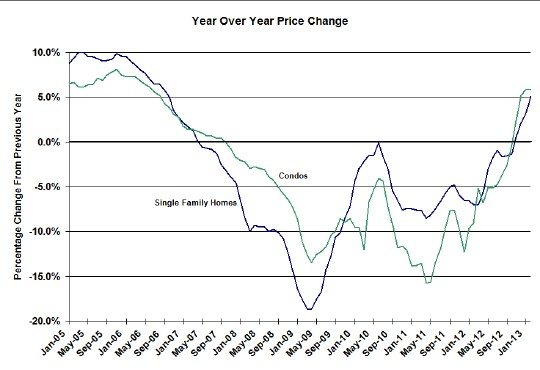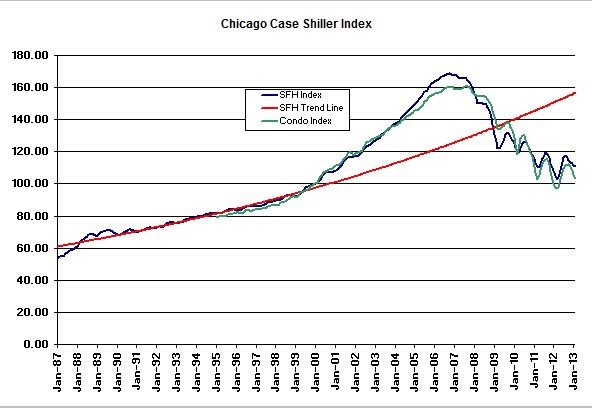For anyone watching the real estate market in Chicago these days it should come as no surprise that the Case Shiller home price index just released shows that Chicago single family home prices were up 5.1% over the 12 month period ending in February. However, as is typical for this time of the year, prices were actually down slightly from January.
On a year over year basis Chicago single family home prices improved at the highest rate in the last 6 years. Condo prices in Chicago improved by 5.9%, which was the same as the improvement shown in January but that’s also a 6 year high. That’s also 4 months in a row where home owners are better off (on average) than they were a year ago. And, as you can see in the graph below, this is a metric that has been decidedly negative for more than 5 years.
According to Case Shiller Chicago home prices actually declined slightly from January to February with single family home prices declining by 0.8% and condo prices declining by 2.4% but as I said above that is normal seasonality. Single family home prices are still 7.7% above the seasonal low reached in March and are back to the levels of April 2001 but that puts them 34.3% below the bubble peak. That leaves them 29.4% below that long term trend line in red in the graph below. Condo prices declined by 2.4% in February, which is 6.3% above the seasonal low and back to the levels of March/ April 2000. Condo prices are now 35.8% below the bubble peak.
According to David M Blitzer, Chairman of the Index Committee at S&P Dow Jones Indices, commenting at the national level:
The 10- and 20-City Composites recorded their highest annual growth rates since May 2006; seasonally adjusted monthly data show all 20 cities saw higher prices for two months in a row – the last time that happened was in early 2005.
Despite some recent mixed economic reports for March, housing continues to be one of the brighter spots in the economy. The 2013 first quarter GDP report shows that residential investment accelerated from the 2012 fourth quarter and made a positive contribution to growth. One open question is the mix of single family and apartments; housing starts data show a larger than usual share is apartments.
He also pointed out that New York, Boston, and Chicago had the lowest year over year price increases of the 20 cities in their composite index. Half of the cities have double digit increases, with Phoenix in the lead at 23%, but Phoenix was one of the hardest hit markets.
If you want to keep up to date on the Chicago real estate market, get an insider’s view of the seamy underbelly of the real estate industry, or you just think I’m the next Kurt Vonnegut you can Subscribe to Getting Real by Email.

